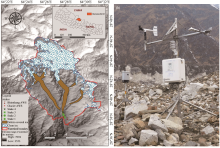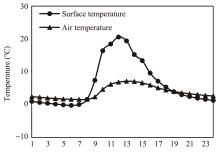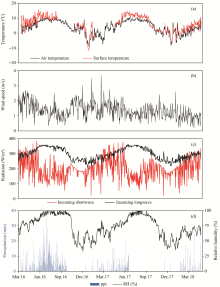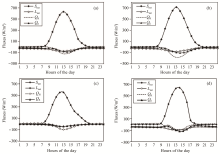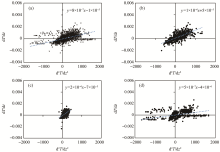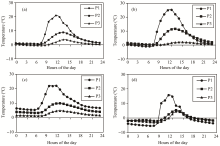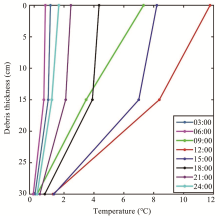Sciences in Cold and Arid Regions ›› 2020, Vol. 12 ›› Issue (5): 261–271.doi: 10.3724/SP.J.1226.2020.00261.
• •
Effect of debris on seasonal ice melt (2016-2018) on Ponkar Glacier, Manang, Nepal
Reeju Shrestha,Rijan B. Kayastha( ),Rakesh Kayastha
),Rakesh Kayastha
- Himalayan Cryosphere, Climate and Disaster Research Center (HiCCDRC), Department of Environmental Science and Engineering, School of Science, Kathmandu University, Dhulikhel 45200, Nepal
| Adhikary S, Nakawo M, Seko K, 2000. Dust influence on melting process of glacier ice: experimental results from Lirung Glacier, Nepal Himalayas. Debris Covered Glaciers: IAHS, 264(264): 43-52. | |
| Bajracharya S, Maharjan S, Shrestha F, et al., 2014. Glacier Status in Nepal and Decadal Change from 1980 to 2010 Based on Landsat Data. International Centre for Integrated Mountain Development (Icimod). | |
| Bozhinskiy AN, Krass MS, Popovnin VV, 1986. Role of debris cover in the thermal physics of glaciers. Journal of Glaciology, 32(111): 255-266. . | |
| Brock BW, Arnold NS, 2000. A spreadsheet-based (Microsoft Excel) point surface energy balance model for glacier and snowmelt studies. Earth Surface Processes and Landforms, 25(October 2015): 649-658. . | |
| Brock BW, Mihalcea C, Kirkbride MP, et al., 2010. Meteorology and surface energy fluxes in the 2005-2007 ablation seasons at the Miage debris-covered glacier, Mont Blanc Massif, Italian Alps. Journal of Geophysical Research Atmospheres, 115(9): D09106. . | |
| Chand MB, Kayastha RB, Parajuli A, et al., 2015. Seasonal variation of ice melting on varying layers of debris of Lirung Glacier, Langtang Valley, Nepal. Proceedings of the International Association of Hydrological Sciences, 368: 21-26. . | |
| Conway H, Rasmussen LA, 2000. Summer temperature profiles within supraglacial debris on Khumbu Glacier, Nepal. Debris-Covered Glaciers, 264: 89-97. . | |
| Fujii Y, 1977. Field experiment on glacier ablation under a layer of debris cover. Glaciological Expedition of Nepal, 33(39): 20-21. . | |
| Fyffe CL, Reid TD, Brock BW, et al., 2014. A distributed energy-balance melt model of an alpine debris-covered glacier. Journal of Glaciology, 60(221): 587-602. . | |
| GDEM_ASTER, 2000. Global Data Explorer (Powered by GeoBrain) | |
| Glazyrin G, 1975. The formation of ablation moraines as a function of the climatological environment. International Association of Hydrological Sciences | |
| Greuell W, Smeets P, 2001. Variations with elevation in the surface energy balance on the Pasterze (Austria). Journal of Geophysical Research: Atmospheres, 106(D23): 31717-31727. . | |
| Hagg W, Mayer C, Lambrecht A, et al., 2008. Sub-debris melt rates on southern Inylchek Glacier, central Tian Shan. In: Geografiska Annaler, Series A: Physical Geography: 90A(1): 55-63. | |
| Taylor & Francis, Ltd. Swedish Society for Anthropology and Geography | |
| Kääb A, Berthier E, Nuth C, et al., 2012. Contrasting patterns of early twenty-first-century glacier mass change in the Himalayas. Nature, 488(7412): 495-498. . | |
| Kayastha RB, Ageta Y, Fujita K, 2005. Use of positive degree-day methods for calculating snow and ice melting and discharge in glacierized basin in the lagtang valley, central Nepal. In: DeJong C, Collins D, Ranzi R (eds.). Climate and Hydrology in Mountain Areas, 2-14. Wiley | |
| Kayastha RB, Ohata T, Ageta Y, 1999. Application of a mass-balance model to a Himalayan glacier. Journal of Glaciology, 45(151): 559-567. . | |
| Kayastha RB, Takeuchi Y, Nakawo M, et al., 2000. Practical prediction of ice melting beneath various thickness of debris cover on Khumbu Glacier, Nepal, using a positive degree-day factor. Debris-Covered Glaciers, 264: 71-81. | |
| Kirkbride MP, 2011. Debris-Covered Glaciers (pp. 180-182). Springer, Dordrecht . | |
| Loomis SR, 1970. Morphology and ablation orocesses on glacier ice. In: Bushnell VC, Ragle RH, (eds.). Icefield Ranges Research Project, Scientific Results, 2(2): 27-31. | |
| Mattson LE, Gardner JS, Young GJ, 1993. Ablation on debris covered glaciers: an example from the Rakhiot Glacier, Punjab, Himalaya. Snow and Glacier Hydrology (Proceedings of the Kathmandu Symposium). IAHS, 218: 289-296. | |
| Mihalcea C, Mayer C, Diolaiuti G, et al., 2006. Ice ablation and meteorological conditions on the debris-covered area of Baltoro glacier, Karakoram, Pakistan. Annals of Glaciology, 43(1894): 292-300. . | |
| Moribayashi S, Higuchi K, 1977. Characteristics of glaciers in the Khumbu Region and their recent variations. Journal of the Japanese Society of Snow and Ice, 39(Special): 3-6. . | |
| Nakawo M, Young GJ, 1981. Field experiments to determine the effect of A debris layer on ablation of glacier ice. Annals of Glaciology, 2(1): 87-91. | |
| Nicholson L, Benn DI, 2006. Calculating ice melt beneath a debris layer using meteorological data. Journal of Glaciology, 52(178): 463-470. . | |
| Oerlemans J, Klok EJ, 2002. Energy balance of a glacier surface: analysis of automatic weather station data from the Morteratschgletscher. Arctic Antarctic and Alpine Research, 34(4): 477-485. . | |
| östrem G, 1959. Ice melting under a thin layer of moraine, and the existence of ice cores in moraine ridges. Geografiska Annaler, 41(4): 228-230. . | |
| Pellicciotti F, Helbing J, Rivera A, et al., 2008. A study of the energy balance and melt regime on Juncal Norte Glacier, semi-arid Andes of central Chile, using melt models of different complexity. Hydrological Processes, 22(19): 3980-3997. . | |
| Purdie J, Fitzharris B, 1999. Processes and rates of ice loss at the terminus of Tasman Glacier, New Zealand. Global and Planetary Change, 22(1-4): 79-91. . | |
| Ragettli S, Pellicciotti F, Bordoy R, 2013. Sources of uncertainty in modeling the glaciohydrological response of a Karakoram watershed to climate change. Water Resources, 49(9): 6048-6066. . | |
| Reid TD, Brock BW, 2010. An energy-balance model for debris-covered glaciers including heat conduction through the debris layer. Journal of Glaciology, 56(199): 903-916. . | |
| Reid TD, Carenzo M, Pellicciotti F, et al., 2012. Including debris cover effects in a distributed model of glacier ablation. Journal of Geophysical Research Atmospheres, 117(17): 1-15. . | |
| Rounce DR, Quincey DJ, McKinney DC, 2015. Debris-covered energy balance model for Imja-Lhotse Shar Glacier in the Everest region of Nepal. Cryosphere Discussions, 9(3): 3503-3540. . | |
| Salerno F, Thakuri S, Tartari G, et al., 2017. Debris-covered glacier anomaly? Morphological factors controlling changes in the mass balance, surface area, terminus position, and snow line altitude of Himalayan glaciers. Earth and Planetary Science Letters, 471: 19-31. . | |
| Scherler D, Bookhagen B, Strecker MR, 2011. Spatially variable response of Himalayan glaciers to climate change affected by debris cover. Nature Geoscience, 4(3): 156-159. . | |
| Shahi S, Kayastha RB, Baral P, et al., 2015. Influence of a debris layer on the melting of ice on Lirung Glacier, Langtang Valley, Rasuwa, Nepal. Journal of Hydrology and Meteorology, 9(1): 95-108. | |
| Singh P, Kumar N, Ramasastri KS, et al., 2000. Influence of a fine debris layer on the melting of snow and ice on a Himalayan glacier. Debris-Covered Glaciers, 264: 63-69. | |
| Watson CS, Quincey DJ, Smith MW, et al., 2017. Quantifying ice cliff evolution with multi-temporal point clouds on the debris-covered Khumbu Glacier, Nepal. Journal of Glaciology, 63(241): 823-837. . |
| No related articles found! |
|
||

